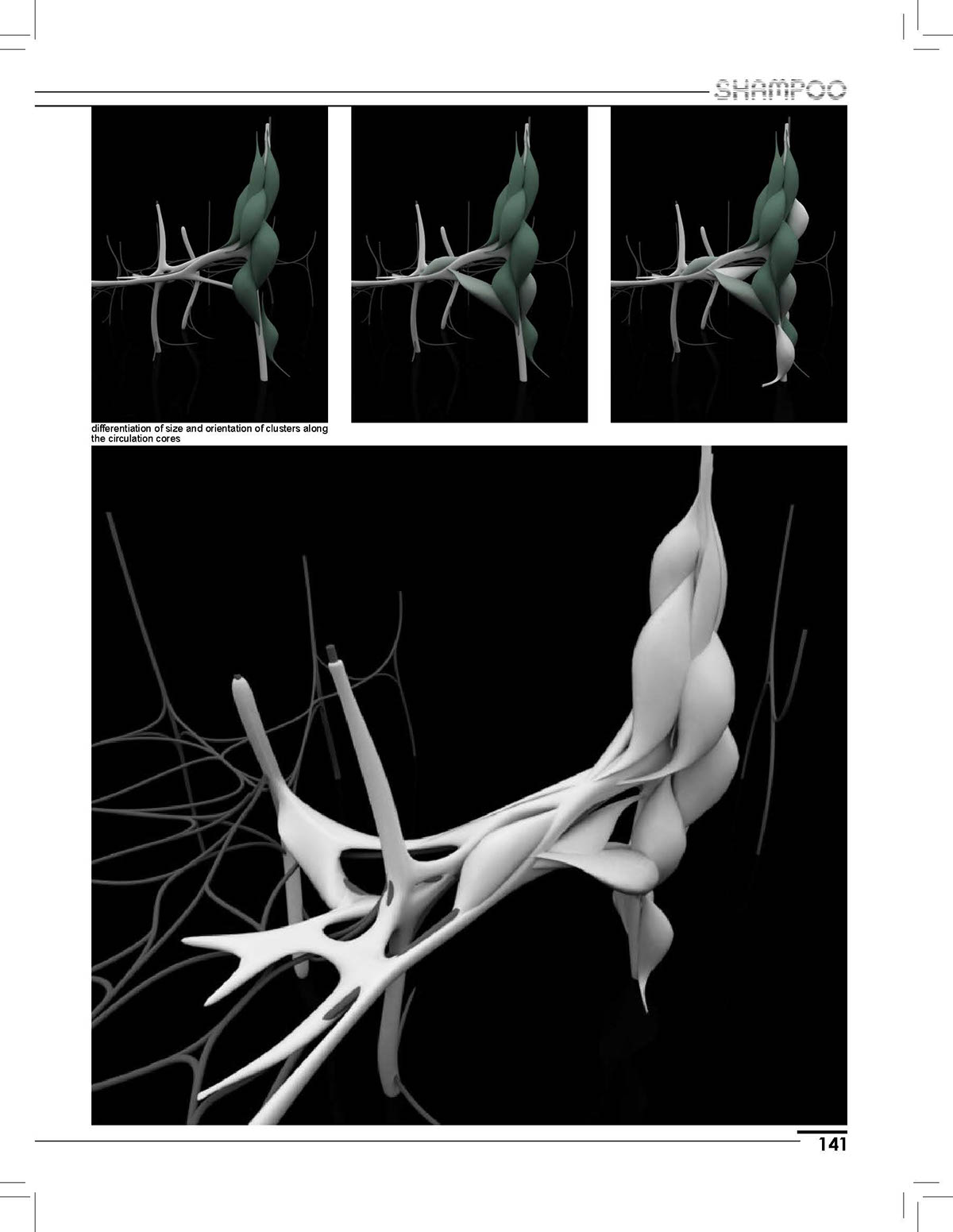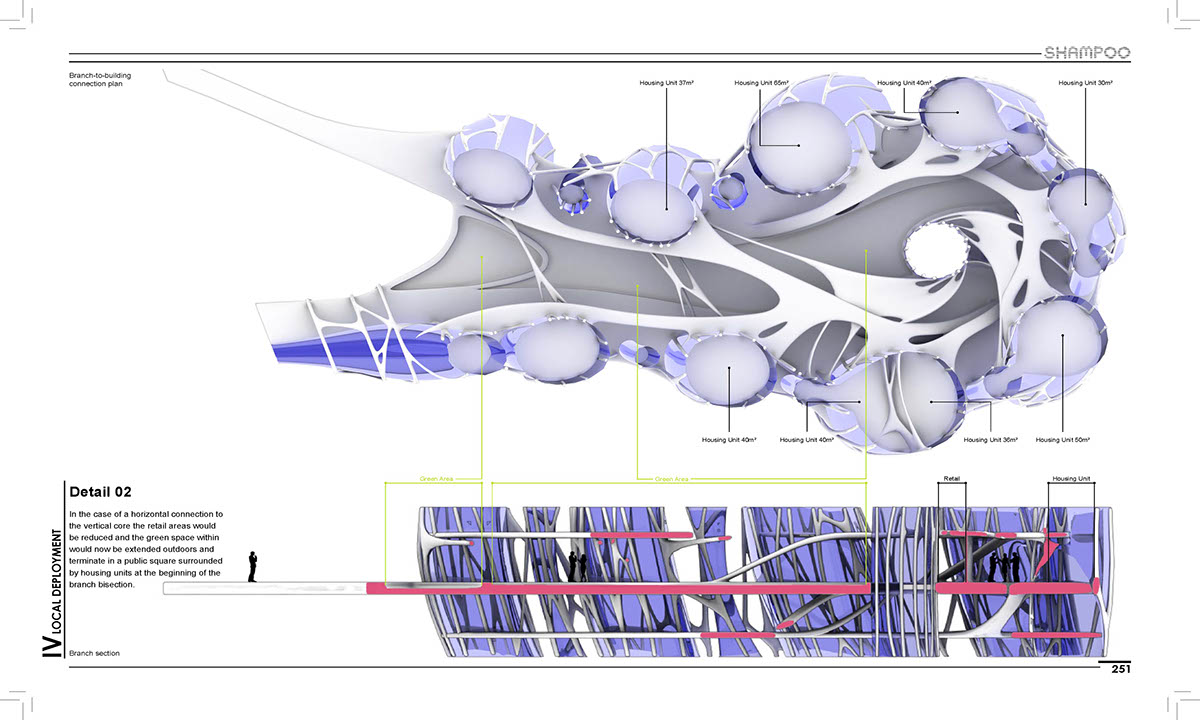














This research focused on the exploration of lines as tool for organizing space and also on emergent global behaviors and local interactions within fields, initially through physical models consisting of grids of rigid lines. To move the research into a digital environment, further explorations were made in the Maya hair dynamics engine. Several tests were developed in the program in order to understand the behavior of flexible and semi-rigid lines within fields that was depending on the application of external and internal forces.
Urban implementation
This project is a housing proposal for the Hudson Yards area of New York. Occupied by a train depot, the site forms a recess in the continuity of the ground plane, while acting both as a physical division that prohibits any connections of the Midtown part of Manhattan to the Hudson River as well as a programmatic boundary with transportation and industrial uses bordering the adjacent residential and commercial areas.
Urban Reef addresses these problems of localized ground discontinuity and programmatic and physical isolation within a larger urban area, by proposing a highly connected three dimensional network of housing integrated with commercial as well as recreational uses. Working to a brief of 3,000 housing units, the normative isolated high-rise building type found in New York, is replaced by a series of mid rise buildings that incline to minimize structural spans and interconnect in order to maximize the area available for housing and communal space development, effectively enhancing social integration.
On an urban scale, a plan of infrastructural nodes located around Hudson Yards is superimposed on a map of hourly pedestrian counts (AM, PM and total counts) at street junctions around the site, with each node acquiring a connectivity value assigned by its nearest pedestrian count location. The organizational logic inherent in Maya hair dynamics is used to optimize the path network of connections between these nodes and subsequently to generate a series of ground plane apertures that would define the positioning and height of the buildings’ vertical circulation cores. Of a number of possible scenarios for the allocation of the buildings between the circulation paths, the one selected is with a continuous mass of housing buildings from midtown Manhattan to the Hudson River, a gesture that would provide programmatic incentives (green spaces and retail areas at ground level) for people to walk through the site, connecting thus the heart of Manhattan to its otherwise ‘natural’ outlet, the riverside pedestrian paths.
This project is a housing proposal for the Hudson Yards area of New York. Occupied by a train depot, the site forms a recess in the continuity of the ground plane, while acting both as a physical division that prohibits any connections of the Midtown part of Manhattan to the Hudson River as well as a programmatic boundary with transportation and industrial uses bordering the adjacent residential and commercial areas.
Urban Reef addresses these problems of localized ground discontinuity and programmatic and physical isolation within a larger urban area, by proposing a highly connected three dimensional network of housing integrated with commercial as well as recreational uses. Working to a brief of 3,000 housing units, the normative isolated high-rise building type found in New York, is replaced by a series of mid rise buildings that incline to minimize structural spans and interconnect in order to maximize the area available for housing and communal space development, effectively enhancing social integration.
On an urban scale, a plan of infrastructural nodes located around Hudson Yards is superimposed on a map of hourly pedestrian counts (AM, PM and total counts) at street junctions around the site, with each node acquiring a connectivity value assigned by its nearest pedestrian count location. The organizational logic inherent in Maya hair dynamics is used to optimize the path network of connections between these nodes and subsequently to generate a series of ground plane apertures that would define the positioning and height of the buildings’ vertical circulation cores. Of a number of possible scenarios for the allocation of the buildings between the circulation paths, the one selected is with a continuous mass of housing buildings from midtown Manhattan to the Hudson River, a gesture that would provide programmatic incentives (green spaces and retail areas at ground level) for people to walk through the site, connecting thus the heart of Manhattan to its otherwise ‘natural’ outlet, the riverside pedestrian paths.
Building scale
On a building scale, research on optimized fibre structures informs the design of the buildings enabling them to have minimal footprints, supported primarily on bundled fibres in order to reduce disruption of the train lines below. Internally, this structural optimization allows the building core to be accessed via a full slab only every 12m, liberating the floors above and below while creating internal voids for the green spaces to be placed around the lift core. As a by-product of the existence of these green spaces internally, a series of interstitial spaces or semiprivate balconies overlooking the green area enhance interaction between the occupants of the surrounding housing units.
Housing scale
As a response to the identification of green space as a significant part of any housing development in New York and Manhattan both historically as well as socially and economically, the proposal reinvents the idea of public space and internalizes parts of what could potentially be an oversized open green space at ground level, into the centre of the building as well as in the horizontal connections between the buildings, transforming these spaces into catalysts for communal urban living as a series of public attractors nested within the three dimensional housing network.
Furthermore, on a housing level, research on natural systems and more specifically the coral reef model as an example of an adaptive ecology that is defined by local relationships, the coral growth principle of increased growth rate at areas of high curvature is used to inform the distribution and positioning of the housing units within the proposed network, while the fusion principle is investigated to differentiate the housing typology according to the parameters of height, orientation and position in the site.
Relationships within this parametric, quasi-natural system are interlinked, phasing dependent and distributed non-linearly across the various scales of the urban project. A change in the ground network set-out can have a knock-on effect on the degree of curvature of parts of the buildings, which can subsequently affect the housing areas on a bulk scale, influencing in its turn the housing unit size and differentiation. Alternatively, dependencies of parts of the project can be cut off from the rest of the system allowing for more autonomous control or reversely allow for the housing values to dictate the network set-out at ground level and effectively the housing building distribution.
On a building scale, research on optimized fibre structures informs the design of the buildings enabling them to have minimal footprints, supported primarily on bundled fibres in order to reduce disruption of the train lines below. Internally, this structural optimization allows the building core to be accessed via a full slab only every 12m, liberating the floors above and below while creating internal voids for the green spaces to be placed around the lift core. As a by-product of the existence of these green spaces internally, a series of interstitial spaces or semiprivate balconies overlooking the green area enhance interaction between the occupants of the surrounding housing units.
Housing scale
As a response to the identification of green space as a significant part of any housing development in New York and Manhattan both historically as well as socially and economically, the proposal reinvents the idea of public space and internalizes parts of what could potentially be an oversized open green space at ground level, into the centre of the building as well as in the horizontal connections between the buildings, transforming these spaces into catalysts for communal urban living as a series of public attractors nested within the three dimensional housing network.
Furthermore, on a housing level, research on natural systems and more specifically the coral reef model as an example of an adaptive ecology that is defined by local relationships, the coral growth principle of increased growth rate at areas of high curvature is used to inform the distribution and positioning of the housing units within the proposed network, while the fusion principle is investigated to differentiate the housing typology according to the parameters of height, orientation and position in the site.
Relationships within this parametric, quasi-natural system are interlinked, phasing dependent and distributed non-linearly across the various scales of the urban project. A change in the ground network set-out can have a knock-on effect on the degree of curvature of parts of the buildings, which can subsequently affect the housing areas on a bulk scale, influencing in its turn the housing unit size and differentiation. Alternatively, dependencies of parts of the project can be cut off from the rest of the system allowing for more autonomous control or reversely allow for the housing values to dictate the network set-out at ground level and effectively the housing building distribution.

